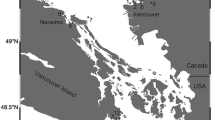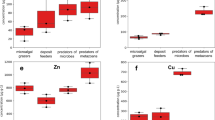Abstract
To determine if toxaphene residues in edible fish tissue decreased after removal of contaminated sediments from an estuarine site in 1999, 51 composite samples representing six finfish species were collected in 2001 and analyzed using gas chromatography with electron capture and negative ion mass spectrometric detection. The grand mean total toxaphene residue concentration on a wet weight basis (ΣTOXwet) was 1,400 ± 3,500 ng g−1 (range: < 18 to 18,000 ng g−1) and was positively correlated with extractable lipid. On a lipid basis, the mean ΣTOXlip was 26 ± 33 μg g1, which decreased with increasing distance from the study site. Although benthically-oriented species, such as spot (Leiostomus xanthurus) and striped mullet (Mugil cephalus), exhibited higher mean ΣTOXwet than those of higher trophic level fish, mean ΣTOXlip were not significantly different among species. The grand mean ΣTOX for 2001 was 3.8 (wet) and 2.6 (lipid) times less than corresponding preremedial action (1997) concentrations, suggesting that bioavailable toxaphene residues in this system have been reduced. Forage species, such as croaker (Micropogonias undulatus), mullet, and spot, preferentially accumulate toxaphene residues in this system and may serve as vectors of organochlorine contaminants in the estuarine and coastal ocean food web.
Similar content being viewed by others
Literature Cited
Bidleman, T. F., M. D. Walla, D. C. G. Muir, andG. A. Stern. 1993. Selective accumulation of polychlorocamphenes in aquatic biota from the Canadian Arctic.Environmental Toxicology and Chemistry 12:701–709.
Black, D. E., R. Gutjahr-Gobell, R. J. Pruell, B. Bergen, L. Mills, andA. E. McElroy. 1998. Reproduction and polychlorinated biphenyls inFundulus heteroclitus (Linnaeus) from New Bedford Harbor, Massachusetts, USA.Environmental Toxicology and Chemistry 17:1405–1414.
de Geus, H. J., H. Besselink, A. Brouwer, J. Klungsoyr, B. McHugh, E. Nixon, G. G. Rimkus, P. G. Wester, andJ. de Boer. 1999. Environmental occurrence, analysis and toxicology of toxaphene compounds.Environmental Health Perspectives 107:115–144.
Fingerling, G. M., N. Hertkorn, andH. Parlar. 1996. Formation and spectoscopic investigation of two hexachlorobornanes from six environmentally relevant toxaphene components under anaerobic conditions.Environmental Science and Technology 30:2984–2992.
Fisk, A. T., B. Rosenberg, C. D. Cymbalisty, G. A. Stern, andD. C. G. Muir. 1999. Octanol/water partition coefficients of toxaphene congeners determined by the “slow-stirring” method.Chemosphere 39:2549–2562.
Georgia Department of Natural Resources (GADNR). 1997. Study plan for the analyses of seafood from Terry and Dupree Creeks, Brunswick, Georgia. GADNR/Environmental Protection Division, Atlanta, Georgia.
Hoekstra, P. F., T. M. O'Hara, C. Teixeira, S. Backus, A. T. Fisk, andD. C. G. Muir. 2002. Spatial trends and bioaccumulation of organochlorine pollutants in marine zooplankton from the Alaskan and Canadian Arctic.Environmental Toxicology and Chemistry 21:575–583.
Kneib, R. T. andA. H. Craig. 2001. Efficacy of minnow traps for sampling mummichogs in tidal marshes.Estuaries 24:884–893.
Lee, R. F. andM. E. Frischer. 2004. The decline of the blue crab.American Scientist 92:2–7.
Mackay, D. andA. Fraser. 2000. Bioaccumulation of persistent organic chemicals: Mechanisms and models.Environmental Pollution 110:375–391.
Maruya, K. A. andR. F. Lee. 1998a. Aroclor 1268 and toxaphene in fish from a southeastern U.S. estuary.Environmental Science and Technology 32:1069–1075.
Maruya, K. A. andR. F. Lee. 1998b. Biota sediment accumulation and trophic transfer factors for extremely hydrophobic PCBs.Environmental Toxicology and Chemistry 17:2463–2469.
Maruya, K. A., S. G. Wakeham, andL. Francendese. 1998. Analysis of toxaphene residues in sediment andFundulus from Terry/Dupree Creek Final Report—Phase I. U.S. Environmental Protection Agency Region 4, Atlanta, Georgia.
Maruya, K. A., S. G. Wakeham, W. Vetter, andL. Francendese. 2000. Prominent chlorobornane residues in estuarine sediments contaminated with toxaphene.Environmental Toxicology and Chemistry 19:2198–2203.
Maruya, K. A., T. L. Walters, andR. O. Manning. 2001. Residues of toxaphene in finfish and shellfish from Terry and Dupree Creeks, Georgia, U.S.A.Estuaries 24:585–596.
Meyer, J. N., D. E. Nacci, andR. T. Di Giulio. 2002. Cytochrome P4501A (CYP1A) in killifish (Fundulus heteroclitus): Heritability of altered expression and relationship to survival in contaminated sediments.Toxicological Sciences 68:69–81.
Miskimmin, B. M., D. C. G. Muir, D. W. Schindler, G. A. Stern, andN. P. Grift. 1995. Chlorobornanes in sediments and fish 30 years after toxaphene treatment of lakes.Environmental Science and Technology 29:2490–2495.
Music, Jr., J. L. and J. M. Pafford. 1984. Population dynamics and life history aspects of major marine sportfishes in Georgia's coastal waters. Georgia Department Natural Resources, Coastal Resources Division, Contribution Series Number 38, Brunswick, Georgia.
Perlmutter, A. 1961. Guide to Marine Fishes. New York University Press, New York.
Reimhold, R. J. andC. J. Durant. 1974. Toxaphene content of estuarine fauna and flora before, during, and after dredging toxaphene-contaminated sediments.Pesticides Monitoring Journal 8:44–49.
Ruppe, S., A. Neumann, E. Braekevelt, G. T. Tomy, G. A. Stern, K. A. Maruya, andW. Vetter. 2004. Anaerobic degradation of compounds of technical toxaphene. II. Fate of hexa- and heptachlorobornanes lacking geminal chlorine atoms.Environmental Toxicology and chemistry 23:591–598.
Saleh, M. A. 1991. Toxaphene: Chemistry, biochemistry, toxicity and environmental fate.Reviews of Environmental Contamination and Toxicology 118:1–85.
Smalling, K. L. andK. A. Maruya. 2001. Gas chromatographic separation of toxaphene residues by DB-XLB.Journal of Separation Science 24:104–108.
Stern, G. A., M. D. Loewen, B. M. Miskimmin, D. C. G. Muir, andJ. B. Westmore. 1996. Characterization of two major toxaphene components in treated lake sediment.Environmental Science and Technology 30:2251–2258.
U.S. Environmental Protection Agency (USEPA). 1980. Ambient water quality criteria for toxaphene. Office of Solid Waste and Emergency Response, USEPA Report no. 440/5-80-076. Washington, D.C.
Vetter, W. andK. A. Maruya. 2000. Congener and enantioselective analysis of toxaphene residues in sediment and biota from a contaminated estuarine wetland.Environmental Science and Technology 34:1627–1635.
Vetter, W., E. Scholz, B. Luckas, andK. A. Maruya. 2001a. Structure of a persistent heptachlorobornane in toxaphene agrees with molecular model predictions.Journal of Agricultural and Food Chemistry 49:759–765.
Vetter, W., K. L. Smalling, andK. A. Maruya. 2001b. Interpreting non-racemic ratios of chiral organochlorines using naturally contaminated fish.Environmental Science and Technology 35:4444–4448.
Williams, R. R. andT. F. Bidleman. 1978. Toxaphene degradation in estuarine sediments.Journal of Agricultural and Food Chemistry 26:280–282.
Author information
Authors and Affiliations
Corresponding author
Rights and permissions
About this article
Cite this article
Maruya, K.A., Francendese, L. & Manning, R.O. Residues of toxaphene decrease in estuarine fish after removal of contaminated sediments. Estuaries 28, 786–793 (2005). https://doi.org/10.1007/BF02732916
Received:
Revised:
Accepted:
Issue Date:
DOI: https://doi.org/10.1007/BF02732916




